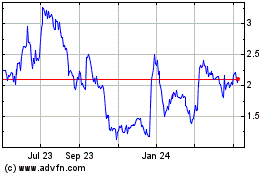CardioNet, Inc. Announces Clinical Study Supporting the Efficacy of CardioNet MCOTTM in Detecting Atrial Fibrillation in Cryp...
November 27 2012 - 8:00AM
Business Wire
CardioNet, Inc. (NASDAQ:BEAT), the leading wireless medical
technology company with an initial focus on the diagnosis and
monitoring of cardiac arrhythmias, today announced the publication
of a new clinical study that further supports CardioNet’s Mobile
Cardiac Outpatient Telemetry (MCOTTM) in detecting a high rate of
atrial fibrillation in cryptogenic stroke.
This new study, titled “Outpatient cardiac telemetry detects a
high rate of atrial fibrillation in cryptogenic stroke,” was
authored by Daniel J Miller, MD, et al, Henry Ford Hospital,
Department of Neurology, and was published online on October 24th
in the Journal of the Neurological Sciences. The study showed that
MCOTTM frequently detects paroxysmal atrial fibrillation in
patients with cryptogenic stroke and transient ischemic attack
(TIA). This study is confirmation of the value of MCOTTM for
monitoring patients with cryptogenic stroke and TIA for atrial
fibrillation, one potential and treatable, cause of stroke.
Dr. Miller, senior author of the study, commented: “This study
highlights the importance of a standardized approach to the
evaluation for potential arrhythmias in patients with cryptogenic
stroke or TIA. Screening with a minimum of 21 days of outpatient
telemetry monitoring with automated arrhythmia detection software
should be considered a routine part of the stroke evaluation in
these patients. Identification and treatment of atrial fibrillation
in these patients will likely reduce the risk of future
stroke.”
Joseph Capper, President and Chief Executive Officer of
CardioNet commented: “I would like to thank Dr. Miller for his
excellent work on this study, which serves as yet another
validation of the many benefits of incorporating CardioNet’s MCOTTM
into the care protocol for a variety of different at-risk patients;
in this case, for patients with cryptogenic stroke and TIA. This
study supplements the extensive portfolio of clinical papers and
abstracts supporting the capabilities and clinical efficacy of the
MCOTTM technology.”
This recent clinical trial supports the results from a previous
study, “Atrial Fibrillation Detected by Mobile Cardiac Outpatient
Telemetry in Cryptogenic TIA or Stroke”, authored by A.H. Tayal,
M.D. et al, Allegheny General Hospital, Comprehensive Stroke Center
and published in the November 18, 2008 issue of Neurology which
concluded that the CardioNet MCOTTM detected a high rate of atrial
fibrillation in patients that have experienced a TIA or stroke.
About CardioNet
CardioNet is a leading provider of ambulatory, continuous,
real-time outpatient management solutions for monitoring relevant
and timely clinical information regarding an individual’s health.
CardioNet’s initial efforts are focused on the diagnosis and
monitoring of cardiac arrhythmias, or heart rhythm disorders, with
a solution that it markets as Mobile Cardiac Outpatient TelemetryTM
(MCOTTM). More information can be found at
http://www.cardionet.com.
Forward-Looking Statements
This document includes certain forward-looking statements within
the meaning of the “Safe Harbor” provisions of the Private
Securities Litigation Reform Act of 1995 regarding, among other
things, our growth prospects, the prospects for our products and
our confidence in the Company’s future. These statements may be
identified by words such as “expect,” “may,” “anticipate,”
“possible,” “estimate,” “potential,” “intend,” “plan,” “believe,”
“forecast,” “promises” and other words and terms of similar
meaning. Such forward-looking statements are based on current
expectations and involve inherent risks and uncertainties,
including important factors that could delay, divert, or change any
of them, and could cause actual outcomes and results to differ
materially from current expectations. These factors include, among
other things, effectiveness of our efforts to address operational
initiatives, including cost savings initiatives that affect our
business, changes to insurance coverage, relationships with our
government and commercial payors and reimbursement levels for our
products, the success of our sales and marketing initiatives, our
ability to attract and retain talented executive management and
sales personnel, our ability to identify acquisition candidates,
acquire them on attractive terms and integrate their operations
into our business, the commercialization of new products, market
factors, internal research and development initiatives, partnered
research and development initiatives, competitive product
development, changes in governmental regulations and legislation,
the continued consolidation of payors, acceptance of our new
products and services and patent protection, adverse regulatory
action and litigation success. For further details and a discussion
of these and other risks and uncertainties, please see our public
filings with the Securities and Exchange Commission, including our
latest periodic reports on Form 10-K and 10-Q. We undertake no
obligation to publicly update any forward-looking statement,
whether as a result of new information, future events, or
otherwise.
HeartBeam (NASDAQ:BEAT)
Historical Stock Chart
From Jul 2024 to Aug 2024

HeartBeam (NASDAQ:BEAT)
Historical Stock Chart
From Aug 2023 to Aug 2024
